
What Is Responsive Design and How Do Responsive Design Tools Aid Website Development
In the contemporary world of web development, responsive design stands as a key strategy for creating websites that adapt and look optimal on various devices and screens. With the proliferation of mobile devices, tablets, and diverse screen sizes, the need for websites to perform well on every device has become indispensable. Responsive design offers a means to achieve this by automatically adjusting the layout and arrangement of content based on the screen size.
Responsive Design - Definition and Significance
Responsive design is an approach where a website dynamically changes and adapts to different screen sizes. This includes optimizing fonts, images, and layout to provide a pleasant and functional experience for users, whether they're on a desktop computer, laptop, tablet, or smartphone.
There are several reasons why responsive design is crucial:
-
User Experience: Users prefer websites that load quickly and look great on their devices. Responsive design enhances the user experience and reduces the likelihood of users leaving the site due to slow loading times or an unsatisfactory appearance.
-
SEO Optimization: Search engines like Google favor responsive websites as they offer a better and consistent experience across devices. This can lead to improved search engine rankings.
-
Development Efficiency: Instead of creating separate versions for different devices, responsive design allows developers to work on a single version of the site. This reduces the time and effort required for maintenance and updates.
Responsive Design Tools - How They Help
Responsive design tools are software solutions that assist web designers and developers in creating and testing responsive websites more easily and effectively. They provide the following advantages:
-
Media Queries: These are CSS techniques that allow designers to apply different styles based on screen size. Responsive design tools offer interfaces that facilitate the creation of media queries without the need for in-depth CSS knowledge.
-
Preview on Different Devices: Many tools provide visualizations of how the website will appear on different devices and screens. This enables designers to see how layout changes will affect the appearance and ensure a cohesive look.
-
Testing Different Resolutions: Responsive design tools enable developers to test how the website behaves under various resolutions and screen sizes, without the need for physical devices.
-
Simulating Internet Speeds: Some tools offer the ability to simulate different internet connection speeds, aiding in evaluating how the website will load on various devices and conditions.
As the web development landscape evolves and a diverse array of devices access the internet, responsive design and its associated tools become increasingly important for the successful presentation of websites. These tools empower designers and developers to create functional and appealing sites that adapt to every screen, providing an excellent user experience.
In both the market and the online space, numerous tools aim to support web designers and programmers in creating a responsive website. In the following sections, we will highlight some of these tools, organized into thematic groups for ease of reference.
Design tools for cross-device web experiences
Grid and Frameworks
• Less Framework
• Semantic Grid System
• Golden Grid System
• Gridless
• Bootstrap
• Gridpak
• Susy
• Tiny Fluid Grid
Scetch Sheets and Wireframes
• Responsive Web Design Scetch Sheets
• Responsive Wireframes
• Style Tiles
JavaScript and JQuery Plugins
• Adapt.js
• Isotope
• Masonry
• Respond.js
• TinyNav.js
• Wookmark
Testing and Preview
• ProtoFluid
• Responsive.Is
• Responsive Web Design Testing Tool
• ReView
• Screenfly
• Responsinator
Sliders
• Blueberry
• Elastislide
• Responsive CSS3 slider
Misc
• Adaptive Images
• FitText.js
• FitVid.Js
•
• Seamless Responsive Photo Grid
• Zurb
• Media Query Bookmarklet
Conclusion:
In conclusion, responsive design remains paramount in modern web development. It ensures websites deliver high-quality functionality across every device. Responsive design tools play a pivotal role in achieving this, providing means to create, test, and optimize websites that attract users and enhance search engine rankings. With the surge of mobile devices and diverse screens, attention to responsive design and its tools is indispensable for achieving a successful and consistently positive web experience.



